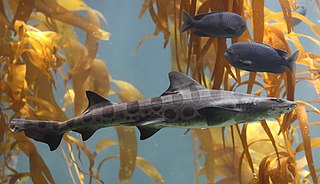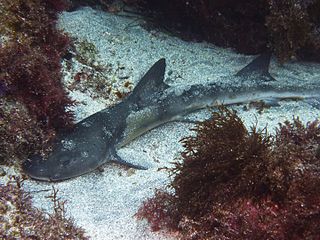
The hammerhead sharks are a group of sharks that form the family Sphyrnidae, so named for the unusual and distinctive structure of their heads, which are flattened and laterally extended into a "hammer" shape called a cephalofoil. Most hammerhead species are placed in the genus Sphyrna, while the winghead shark is placed in its own genus, Eusphyra. Many different, but not necessarily mutually exclusive, functions have been postulated for the cephalofoil, including sensory reception, manoeuvering, and prey manipulation. The cephalofoil gives the shark superior binocular vision and depth perception.

Elasmobranchii is a subclass of Chondrichthyes or cartilaginous fish, including sharks, rays, skates, and sawfish. Members of this subclass are characterised by having five to seven pairs of gill clefts opening individually to the exterior, rigid dorsal fins and small placoid scales on the skin. The teeth are in several series; the upper jaw is not fused to the cranium, and the lower jaw is articulated with the upper. The details of this jaw anatomy vary between species, and help distinguish the different elasmobranch clades. The pelvic fins in males are modified to create claspers for the transfer of sperm. There is no swim bladder; instead, these fish maintain buoyancy with large livers rich in oil.

The wobbegong is the common name given to the 12 species of carpet sharks in the family Orectolobidae. They are found in shallow temperate and tropical waters of the western Pacific Ocean and eastern Indian Ocean, chiefly around Australia and Indonesia, although one species occurs as far north as Japan. The word wobbegong is believed to come from an Australian Aboriginal language, meaning "shaggy beard", referring to the growths around the mouth of the shark of the western Pacific.

Shark liver oil is an oil obtained from the livers of sharks. It has been used for centuries as a folk remedy to promote the healing of wounds and as a remedy for respiratory tract and digestive system problems. It is still promoted as a dietary supplement, and additional claims have been made that it can treat other maladies such as cancer, HIV, radiation sickness, swine flu, and the common cold. To date, none of these claims has been medically validated and shark liver oil (alone) is not a medication prescribed or utilized by American physicians. However, it is a component of some moisturizing skin lotions and hemorrhoid medications.

Houndsharks, the Triakidae, are a family of ground sharks, consisting of about 40 species in nine genera. In some classifications, the family is split into two subfamilies, with Mustelus, Scylliogaleus, and Triakis in the subfamily Triakinae, and the remaining genera in the subfamily Galeorhininae.

The sixgill sawshark, Pliotrema warreni is a sawshark of the family Pristiophoridae. Presence of 6 pairs of gill slits highlights this genus among sharks; outside Hexanchiformes order, Pliotrema is the only shark with more than 5 gill slits. Unlike other sawsharks, the barbs on this shark's rostrum continue onto the sides of the head. Its barbels are also closer to its mouth than in other species. At maximum, females can reach over 136 cm long, and males can reach over 112 cm long.

The Japanese wobbegong is a carpet shark in the family Orectolobidae of the wobbegong family, found in the tropical western Pacific Ocean from Japan and Korea to Viet Nam and the Philippines, between latitudes 43 and 6°N. It reaches a length of 1 m. Japanese wobbegong sharks typically remain motionless during the daytime, and are not active hunters. They use camouflage and their electroreceptor pores on their dorsal area to help them sense prey nearby.

The blacktailed spurdog is a dogfish, a member of the family Squalidae, found around New Caledonia in the central Pacific Ocean, at depths from 320 to 320 m. Its length is up to 75 cm.

The whiskery shark is a species of houndshark in the family Triakidae, and the only member of its genus. This common shark inhabits the Australian continental shelf from Western Australia to the Bass Strait, to a depth of 220 m (720 ft). It is demersal in habits and prefers rocky and vegetated habitats. Stout-bodied and almost "humpbacked" in form, the whiskery shark can be distinguished from all other members of its family by the presence of long nasal barbels. Its two moderately large dorsal fins are roughly equal in size. It is brownish gray above and lighter below, with a pattern of darker saddles and blotches in younger sharks. This species reaches 1.6 m (5.2 ft) in length.

Hemitriakis is a genus of houndsharks in the family Triakidae.

The banded houndshark is a species of houndshark in the family Triakidae, common in the northwestern Pacific Ocean from the southern Russian Far East to Taiwan. Found on or near the bottom, it favors shallow coastal habitats with sandy or vegetated bottoms, and also enters brackish water. This shark reaches 1.5 m (4.9 ft) in length. It has a short, rounded snout and mostly narrow fins; the pectoral fins are broad and triangular, and the trailing margin of the first dorsal fin is almost vertical. It is gray above and lighter below; younger sharks have darker saddles and dots, which fade with age.

The deepwater sicklefin houndshark or the darksnout houndshark, is a houndshark of the family Triakidae. It is found in the western central Pacific, in the Coral Sea off Queensland and in the waters off New Caledonia.

The sicklefin houndshark is a rare houndshark of the family Triakidae, endemic to Western Australia. The holotype was collected from a depth of 150 metres (490 ft) Its reproduction is ovoviviparous.

The Japanese topeshark is a species of houndshark, in the family Triakidae. It can reach a length of up to 1.1 m. It is found in the subtropical northwest Pacific from China, Taiwan, Korea, and Japan, between latitudes 40° N and 21° N.

The whitefin topeshark is a houndshark of the family Triakidae, found only in the tropical waters of the Philippines between latitudes 20° N and 5° N. They inhabit the coastal areas. They can grow up to a length of 96 cm. Adolescent specimens have dark areas on their caudal fins. The reproduction of this shark is ovoviviparous.

The spotless catshark is a catshark of the family Scyliorhinidae found in the South China Sea at depths between 535 and 1,020 m on the continental slope. Its length is up to 71 centimetres (28 in).
The Indonesian houndshark is a species of houndshark in the genus Hemitriakis. It is a tropical houndshark, known from the eastern Indonesian islands of Bali and Lombok, in the Indian Ocean. It was described by William T. White, Leonard J.V. Compagno, and Dharmadi in 2009. Females give birth to live young, with no placenta or yolk sac, and can have between six and 11 pups in one litter. When born, the pups measure 28–30 cm long. At first maturity, the houndsharks measure 90 cm, and males can go on to reach a maximum length of 120 cm, while females can reach a maximum length of 115 cm.
















